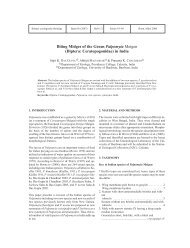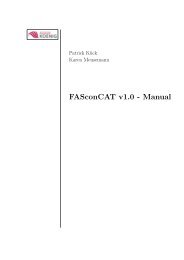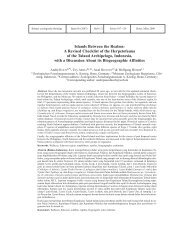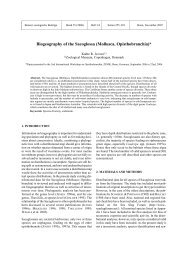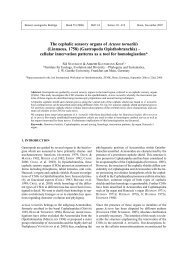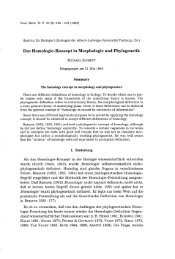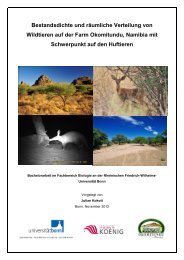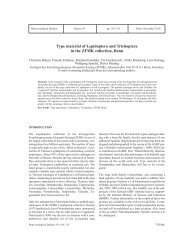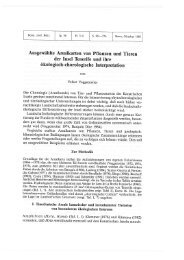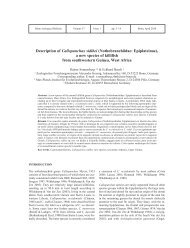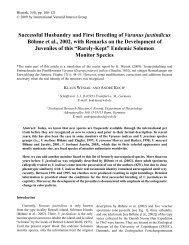Species Composition of Leaf Beetle Assemblages in Deciduous ...
Species Composition of Leaf Beetle Assemblages in Deciduous ...
Species Composition of Leaf Beetle Assemblages in Deciduous ...
You also want an ePaper? Increase the reach of your titles
YUMPU automatically turns print PDFs into web optimized ePapers that Google loves.
306 Bonner zoologische Beiträge 54 (2005)spatak (4 plots) <strong>in</strong> Northern Hungary both lie <strong>in</strong> a lowlandagricultural environment. Some <strong>of</strong> the selectedplots had been untreated, and others treated with broadspectrum<strong>in</strong>secticides (ma<strong>in</strong>ly organophosphorus <strong>in</strong>secticidesand pyrethroids), and also treated with selective<strong>in</strong>secticides (ma<strong>in</strong>ly IGR pesticides) <strong>in</strong> IPM orchards.The samples restricted to the canopies were collectedbetween 1990 and 1994, from April to November, bybeat<strong>in</strong>g methods, us<strong>in</strong>g the W<strong>in</strong>kler-type umbrella (Ø0.7 m) or 0.25 m 2 plastic sheet. Sampl<strong>in</strong>g per year variedbetween 12 and 22 occasions. The number <strong>of</strong> treesper sampl<strong>in</strong>g varied between 10 to 30. Table 1 showsthe parameters <strong>of</strong> each area <strong>in</strong>vestigated.Table 1. Description <strong>of</strong> the orchards <strong>in</strong>vestigated <strong>in</strong> Hungary (after MARKÓ et al. 1995)Woodland <strong>in</strong> hill <strong>of</strong> medium heightAgricultural lowlandNagykovácsi Kecskemét SárospatakFruit species apple pear pear apple apple apple pearAge <strong>of</strong> plantation M M M Y Y M MSize <strong>of</strong> plantation 5.8 ha 1.1 ha 51 ha 2 ha 2 ha 5–6 ha 50.6 haUntreated + +Conventionally+ + + + +treatedIPM applied + + + +No. <strong>of</strong> treatments – – 3–6 7–8 7–8 7–8 7–8Collect<strong>in</strong>g method U U U U S U UYears 1990–92 1992–4 1992–4 1992–3 1992–4 1992–4 1993–4Sampl<strong>in</strong>g per year 12 12 12 12 23–24 21–22 4/19937/1994Trees per sampl<strong>in</strong>g 10 10 12 10 30 branches 10 10M = mature tree, more than 13 years old; Y = younger than 13 years old; U = umbrella; S = plastic sheetInvestigation <strong>of</strong> lime and maple canopies was carriedout <strong>in</strong> Keszthely and vic<strong>in</strong>ity <strong>in</strong> 1999–2002. Keszthelylies <strong>in</strong> the middle <strong>of</strong> Western Hungary at the westernend <strong>of</strong> Lake Balaton, <strong>in</strong> a basically agricultural lowlandenvironment. Collections were made 8–10 times dur<strong>in</strong>gthe vegetation period, us<strong>in</strong>g pyrethroid spray<strong>in</strong>g <strong>of</strong> thewhole canopy and canopy nett<strong>in</strong>g (Ø = 0.5 m). Thenumber <strong>of</strong> trees per sampl<strong>in</strong>g varied between 4 to 10.The composition <strong>of</strong> the chrysomelid communities wascompared by metric ord<strong>in</strong>ation (pr<strong>in</strong>cipal coord<strong>in</strong>ateanalysis—PCoA), based on the Horn <strong>in</strong>dex, after log2transformation <strong>of</strong> the data, and the Jaccard similarity <strong>in</strong>dex(KREBS 1989), us<strong>in</strong>g the Syntax 5.1 program (PO-DANI 1997). The start<strong>in</strong>g data for these analyses wereobta<strong>in</strong>ed by aggregat<strong>in</strong>g all the <strong>in</strong>dividuals collected <strong>in</strong>the canopy <strong>of</strong> the orchard <strong>in</strong>vestigated (apple and pear)or tree species (lime and maple).3. RESULTSTables 2, 3, 4 and 5 show the results obta<strong>in</strong>ed <strong>in</strong> thecanopies <strong>of</strong> the apple and pear orchards. There were atotal <strong>of</strong> 253 Coleoptera species <strong>in</strong> the canopies <strong>of</strong> appletrees and 188 Coleoptera species <strong>in</strong> those <strong>of</strong> pear trees(MARKÓ et al. 1995). At Nagykovácsi, altogether14,917 specimens <strong>of</strong> Coleoptera were collected, <strong>of</strong>which 756 specimens were leaf beetles; there were 176Coleoptera species collected, <strong>of</strong> which 36 were leafbeetlespecies (Table 2). The number <strong>of</strong> leaf-beetlespecimens collected <strong>in</strong> Nagykovácsi <strong>in</strong> 1990–94 appears<strong>in</strong> Table 3. The commonest leaf-beetle species <strong>in</strong> thecanopy <strong>of</strong> conventionally treated pear orchard were Luperusxanthopoda (Schrank, 1781), Phyllotreta atra(Fabricius, 1775), Phyllotreta nigripes (Fabricius, 1775)and Phyllotreta vittula (Redtenbacher, 1849). In theabandoned apple orchards, the commonest was L. xanthopoda,while <strong>in</strong> the untreated pear orchard, the commonestwere L. xanthopoda, Smaragd<strong>in</strong>a (Monrosia)salic<strong>in</strong>a (Scopoli, 1763) and Orsodacne l<strong>in</strong>eola (Panzer,1794). The high proportion <strong>of</strong> L. xanthopoda <strong>in</strong> all orchardswas probably due to the large number <strong>of</strong> wildcherry trees <strong>in</strong> the surround<strong>in</strong>g mixed oak forest. It is <strong>in</strong>terest<strong>in</strong>gthat the number <strong>of</strong> P. vittula was high <strong>in</strong> theconventionally treated pear orchards <strong>in</strong> the years <strong>in</strong>vestigated.This leaf beetle is not a pear-feed<strong>in</strong>g phytophagousspecies, its diet be<strong>in</strong>g restricted to cruciferousplants and grasses (VIG 1998). The reason <strong>of</strong> its occurrence<strong>in</strong> the pear canopy is unknown.




